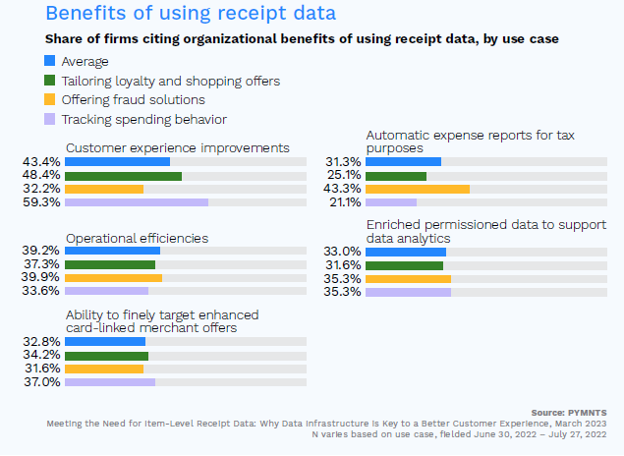43% of FIs and FinTechs Say Using Receipt Data Improves Customer Experience

As businesses continue to seek ways to improve customer experiences and drive operational efficiency, one strategy that is gaining traction is the use of item-level receipt data, which provides detailed information about individual purchases.
In “Meeting the Need for Item-Level Receipt Data: Why Data Infrastructure is Key to a Better Customer Experience,” PYMNTS Intelligence draws on insights from surveys of executives of financial institutions (FIs) and FinTechs to examine the importance of incorporating receipt data into firms’ operations as well as determine the benefits that investing in receipt data will bring to these organizations and the consumers they serve.
According to findings detailed in the joint PYMNTS-Banyan study, by leveraging this data, FIs, FinTechs and merchants can unlock a range of benefits that enhance customer engagement and streamline the purchasing experience.
In fact, 43% of firms expect that using item-level receipt data will result in an improved customer experience, enabling businesses to gain insights into customer preferences, shopping habits and spending behavior.
This information can then be used to tailor offers, rewards programs and shopping deals that are more relevant and appealing to individual customers. For example, merchants can deliver personalized card-linked offers based on specific categories or products, driving increased digital engagement and top-of-wallet spend behavior.
Additionally, item-level receipt data can help businesses mitigate fraud and enhance security measures in the case of post-purchase chargeback fraud, also known as friendly fraud, for example. This type of fraud occurs when a card member disputes a transaction they do not recognize. By leveraging item-level receipt data, businesses can better authenticate transactions, authorize good transactions, and provide consumers with a clearer understanding of their purchases.

The benefits of using item-level receipt data are recognized by both businesses and consumers. According to the study, 72% of companies believe that consumers would be at least somewhat likely to switch to firms that provide solutions based on the use of item-level receipt data in order to benefit from more detailed spending insights, more relevant shopping deals, and a more efficient overall shopping experience.
However, to fully leverage the benefits item-level receipt data offer, businesses need to invest in data infrastructure and available technologies. The study found that technical infrastructure and available technology are the most influential factors when considering strategic innovations using receipt data.
High data-ready firms, which are more prepared to use this data, are more likely to recognize the importance of these factors. They understand that a strong technology base is essential for streamlining innovation efforts and integrating item-level data with existing platforms.